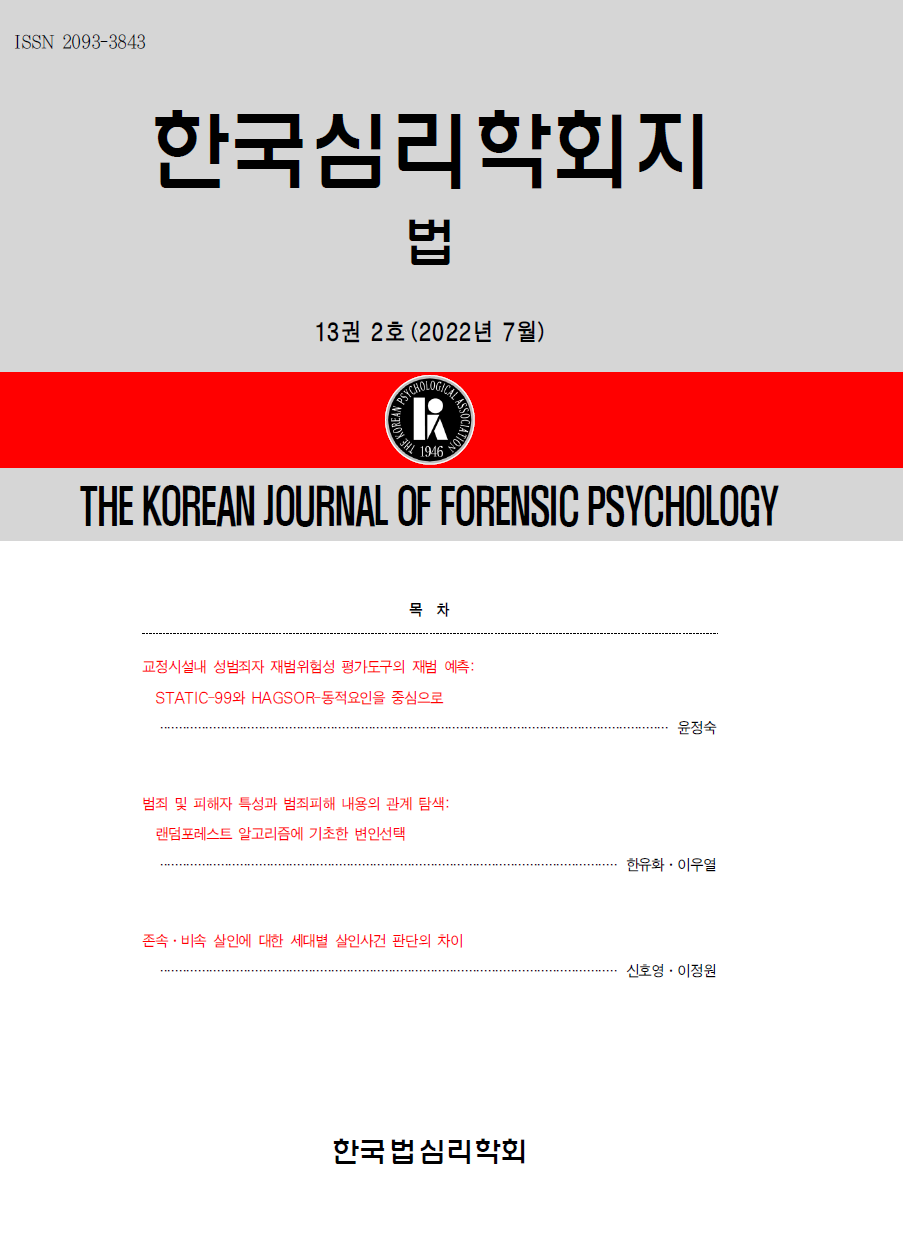 ISSN : 2093-3843
ISSN : 2093-3843
In the present study, subjective likelihood of defendant’s guilt was compared to the posterior probability of guilt predicted by the Bayes’ theorem to examine whether lay people overestimate the posterior probability of guilt and to explore the types of probability in the Bayes’ theorem that may contribute to the overestimation. The difference of conviction threshold among experimental conditions(type of evidence and recognition of logical circularity) were also tested. Finally, individual’s implicit threshold for the decision to convict was calculated based on a logistic regression model in each experimental condition and its effect on the decision to convict was examined. In the result, participants overestimated the posterior probability of defendant’s guilt regardless of the type of sole evidence; their implicit threshold varied over experimental conditions; and the participants who recognized the logical circularity made the verdict by comparing the threshold and the probative value of sole evidence. In discussion, the factors that may have impacts on lay people’s verdict in criminal trials with sole evidence and the necessity of change in policy were discussed.
김동률, 이 훈 (2015). 형사절차에 있어 목격자 등의 범인식별에 미치는 부정적 요인들에 대한 분석. 한국공안행정학회보, 24, 10-40.
김정한 (2015). 증거능력 제한 규정으로 재해석한 형사소송법 제 310 조의 의미와 적용범위. 법학연구, 23(1), 97-121.
대검찰청 (2017). 2017 범죄분석. http://www.spo.go.kr/spo/info/stats/stats02.jsp에서 2018. 3. 16 자료얻음.
대법원 (2006). 2005도8704.
대법원 (2008). 2008도2343.
통계청 (2017). 인구총조사 http://kosis.kr/statHtml/statHtml.do?orgId=101&tblId=DT_1IN1602&conn_path=I2 에서 2017.12.28. 자료얻음.
한유화, 박광배 (2016). 유일한 증거와 일반인의 법적 판단. 한국심리학회지: 법정, 7(1), 1-14.
한유화, 박광배 (2017). 유일한 증거와 일반인의 법적 판단: 순화논증의 오류와 인과추론 경향성. 한국심리학회지: 법, 8(2), 61-79.
DeKay, M. L. (1996). The Difference between Blackstone‐Like Error Ratios and Probabilistic Standards of Proof. Law & Social Inquiry, 21(1), 95-132.
Dhami, M. K. (2008). On measuring quantitative interpretations of reasonable doubt. Journal of Experimental Psychology: Applied, 14(4), 353.
Efron, B., & Tibshirani, R. J. (1994). An introduction to the bootstrap. CRC press.
Fishbein, M., & Ajzen, I. (1977). Belief, attitude, intention, and behavior: An introduction to theory and research. Addison-Wesley.
Hastie, R. (1993). Algebraic models of juror decision processes. In R. Hastie (Ed.), Inside the jury. Cambridge, MA: Harvard University Press.
Hemmens, C., Scarborough, K. E., & del Carmen, R. V. (1997). Grave doubts about ‘reasonable doubt’: Confusion in State and Federal courts. Journal of Criminal Justice, 25, 231-254.
Horowitz, I. A., & Kirkpatrick, L. C. (1996). A concept in search of a definition: the effects of reasonable doubt instructions on certainly of guilt standards and jury verdicts. Law and Human Behavior, 20, 655-670.
Kagehiro, D. K. (1990). Defining the standard of proof in jury instructions. Psychological Science, 1, 194-200.
Kerr, N. (1993). Stochastic models of juror decision making. In R. Hastie (Ed.), Inside the jury. Cambridge, MA: Harvard University Press.
Kerr, N. L., Atkin, R. S., Stasser, G., Meek, D., Holt, R. W., & Davis, J. H. (1976). Guilt beyond a reasonable doubt: Effects of concept definition and assigned decision rule on the judgments of mock jurors. Journal of Personality and Social Psychology, 34(2), 282.
National Registry of Exonerations (2014). The First 1,600 Exonerations https://www.law.umich.edu/special/exoneration/Documents/1600_Exonerations.pdf 에서 2017. 12. 28 자료얻음.
Ostrom, T. M., Werner, C., & Saks, M. J. (1978). An integration theory analysis of jurors’presumptions of guilt or innocence. Journal of Personality and Social Psychology, 36, 436-450.
Peduzzi, P., Concato, J., Kemper, E., Holford, T. R., & Feinstein, A. R. (1996). A simulation study of the number of events per variable in logistic regression analysis. Journal of clinical epidemiology, 49(12), 1373-1379.
Pennington, N., & Hastie, R. (1993). The story model of juror decision making. In R. Hastie (Ed.), Inside the jury. Cambridge, MA: Harvard University Press.
Rasch, G. (1960/1980). Probabilistic models for some intelligence and attainment tests. (Copenhagen, Danish Institute for Educational Research), expanded edition (1980) with foreword and afterword by B. D. Wright. Chicago: The University of Chicago Press.
Tversky, A., & Kahneman, D. (1974). Judgment under uncertainty: Heuristics and biases. science, 185(4157), 1124-1131.
Wright, D. B., & Hall, M. (2007). How a “reasonable doubt” instructions affects decision of guilt. Basic and Applied Social Psychology, 29, 91-98.
Wright, D. B., Strubler, K. A., & Vallano, J. P. (2011). Statistical techniques for juror and jury research. Legal and Criminological Psychology, 16(1), 90-125.